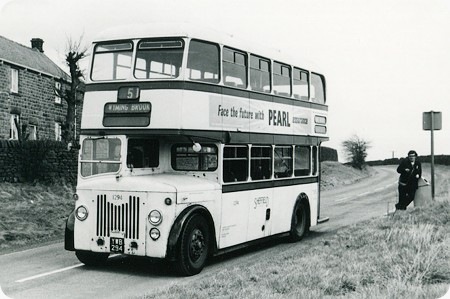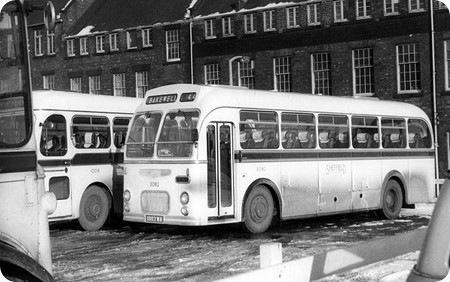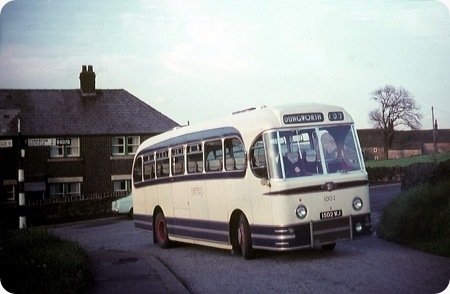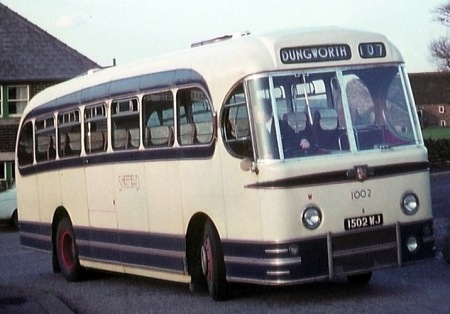
Copyright Ian Wild
Sheffield Corporation
1957
Leyland PD2/20
ECW H31/28R
Sheffield Joint Omnibus Committee took delivery of eight Leyland PD2/20 in 1957 of which five had Eastern Coachworks bodies and the remaining three were bodied by Roe.
The purchase of the three B fleet and two C fleet ECW bodied buses was made possible by the connection with the BTC through the part ownership of the Joint Committee fleets by British Railways.
These bodies were very similar to the those built around the same time on the final Bristol KSW chassis for Brighton Hove and District. They were certainly unique and the first bodies built on non Bristol chassis by ECW for a number of years.
1294 is seen on 31st March 1973 at the remote terminus at Wyming Brook which was an occasional extension of service 51 which normally terminated at Lodge Moor Hospital. The bus is about to reverse into the side road past the conductor who is nonchalantly leaning on what appears to be a rubbish bin watching me take the photograph. By this date the Joint Omnibus Committee was in the past and the bus is displaying Sheffield Transport fleet names but without the City Coat of Arms.
The front fleet number fits very snugly into the blank space originally provided for the Midland Red logo whilst the square front number plate seems to me to give the bus a ‘rabbits teeth’ appearance. I seem to recall that sister buses 1292 and 1293 had more conventional rectangular front number plates.
The bus was withdrawn later in 1973 thus having completed a creditable sixteen years in service.
Photograph and Copy contributed by Ian Wild
A full list of Titan codes can be seen here.
18/05/11 – 06:58
A very smart-looking vehicle in the round. Even when told that it has an ECW body, the BMMO front somehow fools you into not realising it!
The only other non-Bristols I can readily think of as having ECW bodies, were the private-hire AEC Regal IV’s delivered to London Transport in 1951. Their bodies were unique, looking like nothing ECW had produced either before or after! As a nationalised concern, LTE was always subject to its chassis being ECW-bodied, but ECW was never able to cope with the volume demanded of it – with just 15, the RFW’s were an exception.
Chris Hebbron
18/05/11 – 10:20
Yes, Chris – it seems strange to see a non-Bristol with an ECW body, but there were a surprising number of exceptions. LTE not only had the RFWs, but also the Guy Specials (GS). Apart from rebuilds, other examples were the Southdown and East Yorkshire PS1s, the Eastern National and Bristol Omnibus PD1As, the Lowestoft Regent IIs, the Red & White Albions, and the Middlesbrough PD1s and Guys. Yet another example of how fascinating the bus scene was in those days, and I’m sure others can add to the list.
Paul Haywood
18/05/11 – 10:22
This bus like its brethren ended up with Yorkshire Woollen when they had a severe vehicle shortage in the early seventies It joined the ex West Yorks Bristols and South Wales Bridgemasters already shown on this site. Some early Atlanteans also went north to Dewsbury from Sheffield YWD used the top destination box on both ex SWT and Sheffield vehicles to display a fleet name The ex York Bristols had only single aperture boxes and just showed a destination.
Chris Hough
18/05/11 – 10:46
As I keep telling people here in Surrey, half of Sheffield is countryside, a third even in the Peak District. This area was always in Sheffield – certainly post WW 2 and close to where some of my family lived – typical B Fleet country. I always liked the Bristol and Lincolnshire highbridge KSWs, so I had a soft spot for these handsome ECW PD2s. [The C Fleet pair had platform doors – apparently retrofitted at Queens Road.] Sheffield also had B and C Fleet ECW Leopard coaches.
If we’re talking pre 1965 and the Leyland induced freedom, there were at least two other example of non Bristol ECW bodies.
They were:
(i) the 1947(?) AEC Regent II (with bodies like the 7’6" Bristol K highbridge bodies – again see Lincolnshire) delivered to ECWs local authority at Lowestoft, resplendent in very un Tilling maroon and (ii) AEC Regal III for Lough Swilly in Northern Ireland with Bristol L style bodies.
David Oldfield
18/05/11 – 14:12
Are you sure this one went to YWD? They were the C Fleet buses in 1970, after the formation of NBC. STD lost the C Fleet routes and fleet but retained the B fleet buses and most of the routes.
David Oldfield
18/05/11 – 21:55
Sorry for the wrong information about these going to YWD it was the C fleet examples which went north
Chris Hough
18/05/11 – 21:57
As far as I am aware the B and C fleet vehicles never carried the Corporation crest.
1294 and 1296 were still in service in Sheffield in the summer of 1973.
Stephen Bloomfield
18/05/11 – 21:59
If I might hazard a guess (which may be wrong!) the previous non-Bristol deckers bodied by ECW prior to these were a batch of seven for Midland General in 1955. Six were re-bodies on Guy Arab II’s and the seventh was an AEC Regent III whose original Weymann body had been badly damaged in an accident. All were highbridge. I believe the AEC was the only Regent III ever to be bodied by ECW.
As an aside, it’s just possible that the MGO Guys and the Sheffield PD2’s could have met in Chesterfield, albeit working to different termini.
Chris Barker
19/05/11 – 06:38
The MGO Guys and ECW bodied PD2’s could have met at the same terminal in Chesterfield, Beetwell Street. Could have operated on service 99 and possibly one other.
Between 1951 and 1953 Western S.M.T rebodied Guy Arab II’s, Daimler CWA6’s, Albion Venturers and some Leyland PD1’S.
Stephen Bloomfield
19/05/11 – 09:38
C fleet 1153 was sent to Dewsbury in 1970 and lasted until 1972
Chris Hough
20/05/11 – 06:56
Sheffield Joint Omnibus Committee service 99 was a single deck route due to very low bridges at barrow hill.
Ken Wragg
22/05/11 – 08:37
With respect to the two ‘C’ fleet ECW PD2’s that were transferred to Yorkshire Woollen in 1970, an interesting point is that although they were transferred to YWD ‘on paper’ as of January 1st, 1970, due to a shortage of buses in Sheffield at the time, 3152/3 (YWB 152/3) were operated by STD from Greenland Road garage ‘on hire’ from the National Bus Company until the 1st of May that year, when they were finally sent up the road to Dewsbury!
Presumably the legal lettering on these buses would have been changed to reflect their new owner as of the beginning of the year. That being the case, I wonder then if they operated for those four months with ‘On Hire to STD’ posters displayed in the front nearside window? If so, this would have looked quite odd, considering they were in full Sheffield livery at the time!
Dave Careless
31/05/16 – 06:20
ECW bodies built until around 1950 were ordered prior to Transport Act 1947 provisions coming in, they prevented ECW building for anyone other than 100% state-owned operators, like (in Sheffield’s case) the British Railway’s board.
Not only did that stop (Bristol and) ECW supplying previously loyal customers on the home market but it also killed a promising export trade, in ECW’s case including AEC Regals for the Londonderry & Lough Swilly Railway and Leyland Tigers for Isle of Man Road Transport.
One ECW body for London Transport mentioned was the fourth prototype Routemaster.
In 1965 Leyland Motor Corporation exchanged a 30% holding in Park Royal Vehicles and Charles H. Roe for a 25% interest in Bristol Commercial Vehicles and Eastern Coach Works, by the end of 1966 Bristol and ECW products were back on open sale.
Stephen Allcroft




